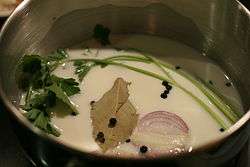Béchamel sauce
Béchamel sauce (/ˌbeɪʃəˈmɛl/;[2] French: [beʃamɛl]), also known as white sauce, is a sauce that originated in Italy[3], later introduced to France, made from a white roux (butter and flour) and milk.
 Milk infusing with bay leaf, peppercorns, shallot and flat-leaf parsley prior to being added to the roux | |
| Alternative names | White sauce, Salsa Colla |
|---|---|
| Type | Sauce |
| Place of origin | France Italy Medieval World International suggests that Salsa Colla was brought to France by Catherine de Medici along with her Florentine chefs and cuisine in 1533.[1] |
| Main ingredients | Butter, flour, milk |
| Variations | Mornay sauce |
Known as Salasa Colla (Glue Sauce) in 14th century Tuscany,[4] it has been considered, since the seventeenth century,[5][6] one of the mother sauces of French cuisine.[7] It is used as the base for other sauces (such as Mornay sauce, which is Béchamel with cheese).[8] One typically finds the sauce in a lasagne, between the pasta sheets and above the upper pasta sheets (below the cheese topping).
Origin
The Italian origin of the sauce is Tuscany, specifically Florence. The sauce is a mainstay sauce of the Italian cuisine, particularly Emilian and Tuscan sub-cuisines whose ingredients remain butter, flour, milk and nutmeg. It is used in dishes such as Lasagne al Forno and Crespelle alla Fiorentina.[9] Louis de Béchamel, Marquis de Nointel, was a financier who held the honorary post of chief steward to King Louis XIV of France. The earliest mention of the name appears in Cuisinier François, the foundation of French cooking published in 1651 by François Pierre La Varenne (1615–1678).
The sauce originally was a veal velouté, with a large amount of cream added.[10]
A recipe published in 1749 gave a modern and a traditional version of béchamel. The traditional one was made by melting butter in a pan, and then frying the peels of onions and root vegetables, green onions, and parsley in it; after cooking, cream was added, along with salt, coarse ground black pepper, and nutmeg. This was boiled, strained, and served with extra butter.
The more modern recipe was to fry minced shallot, parsley, and green onion in butter, adding cream, salt, coarse ground black pepper, and nutmeg, as before, but then to add additional parsley and serve without straining.[11] A 1750 recipe for turbot involved cooking the fish in broth, cooling it, and then reheating it in béchamel immediately before serving.[6]
See also
References
- https://www.facebook.com/Roger.MWUSA/posts/the-origins-of-white-sauce-salsa-colla-ou-colletta-besciamella-bechamelbalsamell/666079166738235/
- "Béchamel definition". Merriam-Webster.
- texte, La Varenne (1618-1678) Auteur du (1654). Le Cuisinier françois... par le sieur de La Varenne,...
- Libro di Cucina del Secolo XIV, Ludovico Frati, Livorno 1899 https://warburg.sas.ac.uk/pdf/dch272b2372452.pdf
- François Marin, Les Dons de Comus, ou les Délices de la table, préface par les PP. Pierre Brumoy et G. H. Bougeant, Paris : Prault Fils, 1739, pp. 103 et seq.
- M.C.D. Chef de Cuisine de M. le Prince de *** [i.e. Briand], Dictionnaire des alimens, vins et liqueurs, leurs qualités, leurs effets... avec la manière de les apprêter ancienne et moderne..., Paris : Gissey, 1750, 576 p., p. 34 et seq.
- Michael Ruhlman, The Elements of Cooking: Translating the Chef's Translating the Chef's Craft for Every Kitchen, New York : Scribner, 2007, p. 171.
- Delmy Dauenhauer, 10 Ways to Use Béchamel Sauce, London : SamEnrico, 2015, ISBN 9781505738384.
- it:Besciamella
- Larousse Gastronomique.
- Menon (17-17; écrivain culinaire) (1749). La science du maître d'hôtel cuisinier, avec des observations sur la connaissance & propriétés des alimens (in French). Paulus-Du-Mesnil (Paris). p. 535.
External links
- History and legends of Béchamel sauce
- Free Culinary School Video Episode 11—An educational podcast episode that talks about the classical French technique used for making Sauce Béchamel and a few secondary sauces including Mornay, Basic Cream, Cheddar Cheese and Mustard Sauce.
- . New International Encyclopedia. 1905.